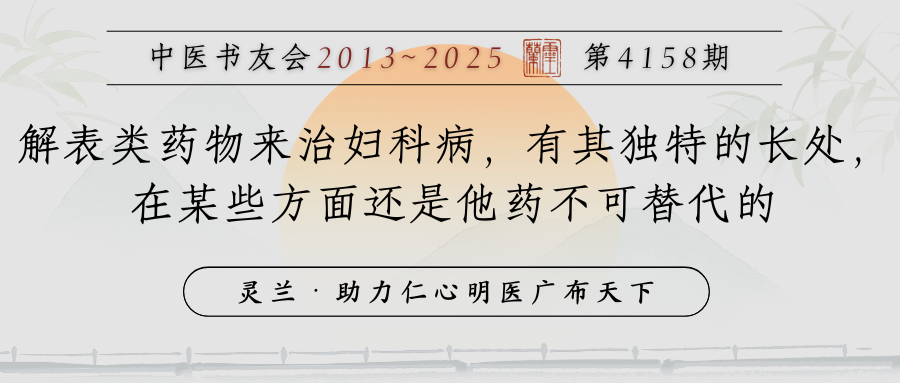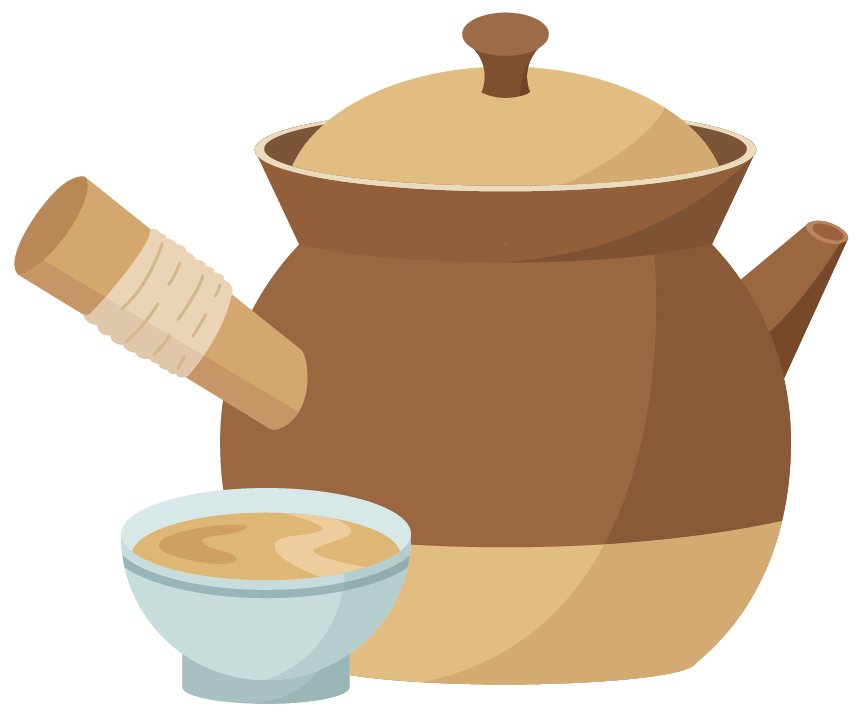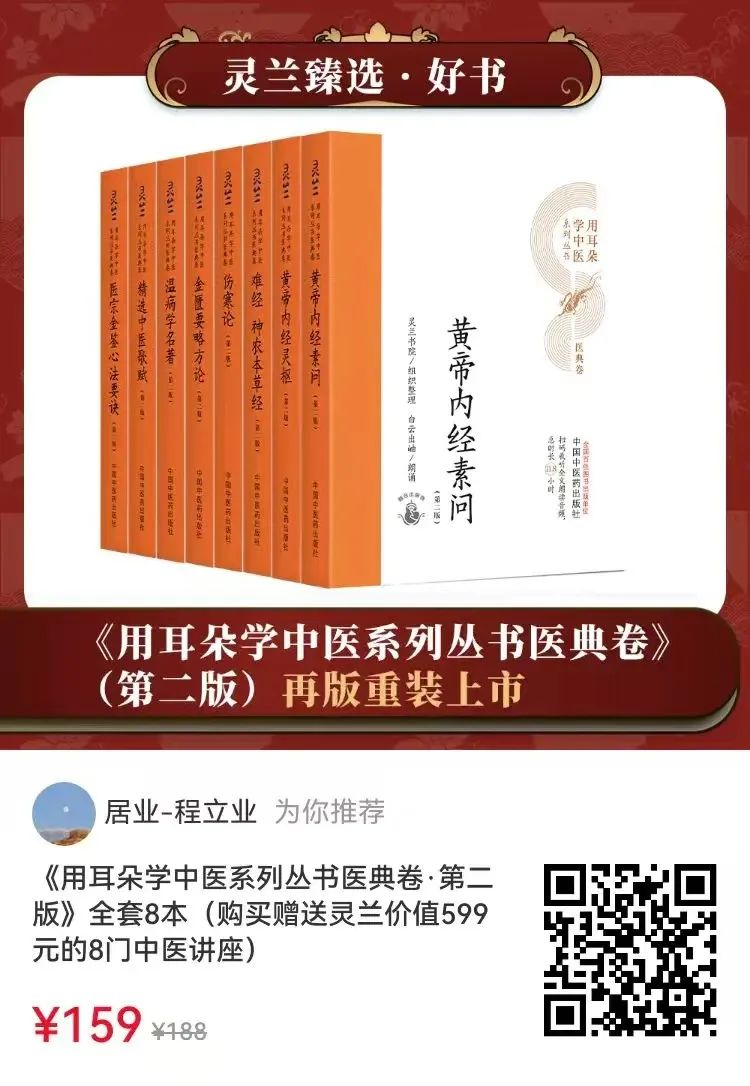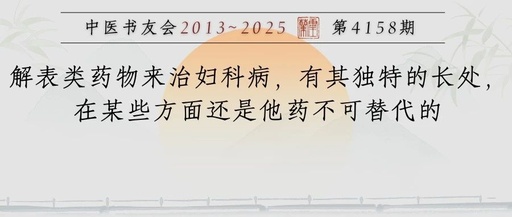
 Chinese Medicine Book Club Issue 4158One issue daily, accompanying the growth of TCM practitioners
Chinese Medicine Book Club Issue 4158One issue daily, accompanying the growth of TCM practitioners
IDeepSeek Introduction:This article summarizes the various uses of exterior-releasing herbs in gynecology, with a clear structure and numerous examples, making it practical! For instance, Jing Jie Tan (Schizonepeta Powder) stops bleeding, and Fang Feng Tan (Siler Powder) treats metrorrhagia. It also cites ancient texts and modern doctors’ experiences, enhancing its credibility. Exterior-releasing herbs can both uplift Yang Qi to treat uterine prolapse and soothe the liver to alleviate dysmenorrhea, as well as treat mastitis and induce lactation, showcasing their versatility. However, some traditional methods lack clarity regarding modern scientific principles, and the dosages and indications are somewhat vague. Overall, the practicality is strong, providing significant help for TCM gynecological prescriptions, reflecting the wisdom of TCM’s principle of treating different diseases with the same method.
—This article is approximately3258words, expected reading time9minutes—
Brief Discussion on the Application of Exterior-Releasing Drugs in Gynecology
Author/Ma DazhengIntroduction:Ma Dazheng, born in February 1949, male, from Wenzhou, Zhejiang, Chief TCM Physician, Professor, PhD Supervisor at Zhejiang University of Traditional Chinese Medicine, Master’s Supervisor at Shanghai University of Traditional Chinese Medicine, a national expert in TCM from the third, fifth, sixth, and seventh batches, and a renowned TCM master in Zhejiang Province. Born into a family of medicine, he entered the TCM department of Zhejiang College of Traditional Chinese Medicine in 1977, graduated, and studied under the famous teacher Wu Guodong, establishing the well-known “Ma’s Gynecology” in southern Zhejiang. He is the chief editor of the gynecology volume of the “Collection of Rare Ancient TCM Texts” and has published over 100 medical articles and 17 books. In the field of Chinese herbal medicine, the number of exterior-releasing drugs is quite considerable. Their main function is to relieve the exterior, promote sweating, and resolve exterior symptoms, as stated in the Neijing: “If it is on the skin, it should be released by sweating.” However, the application of exterior-releasing drugs in the treatment of gynecological diseases is quite common. Summarizing their usage patterns, they can be roughly divided into functions such as stopping bleeding, uplifting Yang and dispelling dampness, regulating Qi and soothing the liver, warming and unblocking, and detoxifying. The details are as follows:
In the field of Chinese herbal medicine, the number of exterior-releasing drugs is quite considerable. Their main function is to relieve the exterior, promote sweating, and resolve exterior symptoms, as stated in the Neijing: “If it is on the skin, it should be released by sweating.” However, the application of exterior-releasing drugs in the treatment of gynecological diseases is quite common. Summarizing their usage patterns, they can be roughly divided into functions such as stopping bleeding, uplifting Yang and dispelling dampness, regulating Qi and soothing the liver, warming and unblocking, and detoxifying. The details are as follows:
1. Hemostatic Effects
Jing Jie Chao Tan (Fried Schizonepeta) is the most commonly used drug for gynecological blood disorders. Furen Liangfang uses it to treat metrorrhagia; Hua Tuo’s Yufeng San also uses this herb as a powder, taken with wine, to treat postpartum blood collapse. The ancient formula Juqing Guba San subtly uses the name derived from the pronunciation of “Jing Jie” and has been widely recorded in gynecological medical texts throughout history.Similar to Jing Jie, Fang Feng Chao Tan (Fried Siler) can also be used for metrorrhagia. The formula Dusheng San uses fried Fang Feng powdered, and predecessors have commented, “This drug has been proven effective over the years.”Due to the warm nature of these two herbs, which need to be fried until black, they are suitable for light-colored bleeding in metrorrhagia, with a common dosage of 9 grams.Bai Zhi Chao (Fried Angelica Dahurica) is also a commonly used drug for treating metrorrhagia. Yao Xing Lun states it is “mainly for women’s blood collapse,” and in the Taichan Xinfa, Bai Zhi is used in the Jing Jie Zhi Beng Tang for treating metrorrhagia.Ying Jian Liang Fang uses Man Jing Zi (Vitex) combined with ginger, fried and crushed, decocted with water and wine, to treat women’s menstrual blood heat causing metrorrhagia.Winter Mulberry Leaves are rarely used in clinical practice for treating gynecological blood disorders. Ben Cao Cong Xin states it can “cool the blood and stop bleeding.” In Fu Qingzhu Nüke, it is included in the modified Dang Gui Bu Xue Tang for treating elderly blood collapse (the formula includes 1 liang of Dang Gui, 1 liang of Huang Qi, 3 qian of San Qi root powder, and 14 pieces of mulberry leaves), believed to have a “constricting effect.” Based on my clinical practice, this formula uses Winter Mulberry Leaves up to 30 grams, removing Dang Gui, and adding 15 grams of Sheng Di, which has shown good efficacy for elderly patients with Yin deficiency and blood heat type metrorrhagia.Additionally, Sheng Ma, Mu Zei, and Dou Chi can also be used for gynecological blood disorders. Among them, Sheng Ma Chao Tan (Fried Cimicifuga) has good efficacy for metrorrhagia due to Qi deficiency. Sheng Hui Fang uses Mu Zei fried to treat continuous menstrual flow; Sheng Ji Zong Lu uses Mu Zei without nodes, combined with Chuan Xiong, to treat unsettled fetal movement. Zi Mu Mi Lu uses Dou Chi mixed with powdered deer antler to treat abortion bleeding.My mentor, Wu Guodong, often uses Zhi Zi Chi Tang (9 grams each of fried Zhi Zi and Dou Chi) to treat women with metrorrhagia accompanied by feelings of distress, which has shown good efficacy. Since all these herbs have the effect of relieving wind-heat, they are particularly suitable for excessive menstruation due to wind-heat disturbing the uterus.Mr. Ding Guangdi created the Ji Wan Beng Lou Tang, composed of fried Fang Feng, Jing Jie Tan, Bai Zhi, Gao Ben, Qiang Huo, Du Huo, Bai Zhu, Sheng Ma, Chai Hu, Zhi Huang Qi, Zhi Gan Cao, and Dang Gui, additionally using ginseng decoction to adjust and take with lotus seed carbon, used to treat sudden blood collapse, uplifting the Yang Qi that has fallen, and regulating the extraordinary meridians, demonstrating a deep understanding of how wind herbs can enter the blood.
2. Uplifting Yang and Dispelling Dampness Effects
Wind herbs ascend and can dispel dampness, thus possessing the effect of uplifting Yang and dispelling dampness.
Sheng Ma and Chai Hu can be added to formulas that tonify the middle Qi, enhancing Qi and uplifting, treating metrorrhagia, leukorrhea, uterine prolapse, and many other diseases caused by sinking middle Qi. The Fu Qingzhu Nüke formula Wan Dai Tang uses Chai Hu and Jing Jie Sui (combined with Bai Zhu, Shan Yao, Ren Shen, Bai Shao, Che Qian Zi, Cang Zhu, Chen Pi, and Gan Cao) to ensure that “the wind wood does not block the earth, thus the earth Qi rises to the heavens, the spleen Qi is strong, and the dampness dissipates,” which conveys this meaning.Zi Mu Mi Lu uses Qiang Huo (2 liang) decocted with wine to treat uterine prolapse. Bai Zhi detoxifies and dispels dampness; the Furen Liangfang uses Bai Zhi San (Bai Zhi, Hai Sha, and fetal hair) to treat red and white leukorrhea. Ge Gen also has the effect of uplifting clear Yang, combined with Guan Zhong Tan and Bai Cao Shuang to form pills, can treat red leukorrhea. If dampness is excessive with leukorrhea, causing lower back pain, adding 6 grams of Qiang Huo to the Zhi Shi Zhi Dai Fang can enhance efficacy.
3. Regulating Qi and Soothing the Liver Effects
Wind herbs are known for their ability to move, especially the spicy and warm exterior-releasing herbs, thus they are often used to regulate Qi or soothe the liver.
Zi Su can regulate Qi and calm the fetus; the Ben Shi Fang Zi Su Yin (Zi Su stems and leaves, Da Fu Pi, Ren Shen, Chuan Xiong, Chen Pi, Bai Shao, Dang Gui, Gan Cao) is a famous formula for treating fetal suspension. The common dosage is 6-9 grams.Cong Bai is an excellent herb for opening Yang and regulating Qi to calm the fetus. The Yang Shi Chan Ru Ji Yan Fang uses Cong Bai to treat “pregnancy movement in June, difficult to save.” Generally, three stems of Cong Bai are added to the formula, yielding satisfactory results.Li Shizhen stated that Dou Chi is “the best for regulating the middle and lowering Qi,” and recorded Hua Tuo’s formula, “for fetal movement during pregnancy, Dou Chi juice is effective.” The common dosage is 10 grams. Zan Yin’s Jing Xiao Chan Bao includes the above two herbs used together to treat fetal movement instability, not limited to external pathogens. If caused by external pathogens, it is even more suitable, often yielding effective results. Xu Shuwei treated febrile diseases with fetal death in utero using 1 liang of deer antler shavings, 5 stems of Cong Bai, and half a cup of Dou Chi decocted for consumption.Fang Feng is included in Qi-regulating formulas, which can treat abdominal pain due to blood Qi before menstruation, due to the nature of wind herbs being good at movement. The Yi Xin Fang includes a formula for elderly women (medications include Fang Feng, Hou Po, Zhi Shi, Bai Zhu, Jie Geng, Gan Cao, and Sheng Jiang), which has significant efficacy.Chai Hu is good at soothing liver Qi; the Chai Hu Shu Gan San (Chai Hu, Zhi Shi, Bai Shao, Xiang Fu, Chuan Xiong, Gan Cao) is a representative formula. Bo He can also soothe the liver and open stagnation, and in the Xiao Yao San, these two herbs complement each other. Using Gui Zhi to soothe the liver is a special method; in fact, the Ben Cao Jing Jie Lun has already stated it “enters the foot Jue Yin liver meridian,” and “spicy and warm can smooth the liver Qi.” It is suitable for stagnation without heat, blockage with symptoms, such as bloating and pain in the chest and flanks before menstruation, with a recommended dosage of 3-5 grams. Nüke Jing Yao treats postnatal flank pain using “Four Gentlemen Decoction plus Chai Hu, Bo He, and Gui Zhi.”
4. Warming and Unblocking Effects
Xi Xin has remarkable effects in dispersing cold and stopping pain, commonly used for dysmenorrhea. The Dang Gui Si Ni Tang (Dang Gui, Gui Zhi, Bai Shao, Tong Cao, Xi Xin, Zhi Gan Cao, Da Zao) has good efficacy for treating dysmenorrhea.Bai Zhi also has analgesic effects; Yao Xing Lun states it “treats women’s blood loss and lower abdominal pain.” Hunan Yao Wu Zhi uses fried Bai Zhi, decocted in water, to treat dysmenorrhea and leukorrhea.Cong Bai fried and applied as a hot compress on the navel has good efficacy for treating postpartum urinary retention.Ma Huang is referred to in the Da Ming Ben Cao as a product that can “open the nine orifices and regulate blood vessels”; the Yang He Tang (Ma Huang, Bai Jie Zi, Lu Jiao Jiao, Shu Di, Pao Jiang, Rou Gui, Gan Cao) is used for cold obstruction causing lower abdominal pain and leukorrhea, showing considerable efficacy. The dosage of Ma Huang is 5 grams, and if combined with orange seeds, lychee seeds, and fennel, the effect is even better.Furen Daqian Liang Fang uses fried Qiang Huo decocted in wine to treat postpartum abdominal pain, which has been modernly made into vinegar for use.
5. Warming the Middle and Descending Rebellious Qi Effects
Gui Zhi has good warming effects on the middle and can treat pregnancy nausea due to coldness in the spleen and stomach; the Gui Zhi Tang has good efficacy.Zi Su has excellent effects of warming the middle and descending rebellious Qi. For different types of nausea, Xiang Su San (Xiang Fu, Zi Su Ye, Chen Pi, Gan Cao) or Zi Su Ye Huang Lian Tang (Zi Su Ye, Huang Lian) can be selected for treatment. If there is significant Qi rebellion, Zi Su stems can be used for better effects in regulating Qi and broadening the chest.Coriander is a less commonly used herb among exterior-releasing drugs, but it can aromatically open the stomach; for pregnancy nausea, it can be decocted in water, and its aroma can awaken the spleen and stomach to descend rebellious Qi.
6. Clearing Heat and Detoxifying Effects
Niubangzi is effective for treating sores and reducing swelling; the Wai Ke Zheng Zong Niubangzi Tang (Niubangzi, Chen Pi, Shan Zhi, Yin Hua, Gan Cao, Lou Ren, Huang Qin, Tian Hua Fen, Lian Qiao, Zao Jiao Ci, Chai Hu, Qing Pi) is a famous formula for treating mastitis.Sheng Ma has detoxifying and pus-discharging effects; for leukorrhea with purulent odor, adding 30 grams of Sheng Ma to the formula can yield quick results.Chrysanthemum can treat pregnancy nausea due to stomach heat; Ben Cao Xin Bian states it “can calm the fire in the stomach without harming the stomach Qi,” making it suitable for patients with stomach heat or mixed cold and heat nausea. Its flowers, roots, and leaves can be crushed, and taken with wine, while the residue can be applied to the affected area, treating women’s mastitis.Using Qiang Huo (6 grams), and 60 grams of Chen Jiu, can treat acute mastitis.
7. Other Effects
Bai Zhi can also be used for difficult labor; Tang Yao Jing Yan Fang uses 5 qian of Bai Zhi, decocted in water; if combined with Bai Cao Shuang, it is known as Heishen San, a famous formula for treating reverse birth. Some people use Bai Zhi to induce lactation, combined with Dang Gui, Sheng Huang Qi, Wang Bu Liu Xing, Pao Shan Jia, and Tong Cao; additionally, it can be used alone to treat mastitis internally or externally for nipple fissures.Wei Sheng Bao Jian uses Man Jing Zi alone as a powder, mixed with Cong Bai soup, to treat postpartum urinary retention. Shi Yi De Xiao Fang uses it alone, fried, as a powder taken with wine, to treat initial mastitis. Xiu Zhen Fang combines Zao Jiao Ci burned to a char, taken with warm wine to treat insufficient milk production.Chansui (15 grams) combined with Mai Ya (60 grams) can induce lactation; Chansui (3 grams) burned to ash and taken with boiled water can treat nausea. Taken alone (removing head and feet) at 9 grams can treat postpartum urinary retention; taken alone at 20 grams, decocted, and combined with 30 grams of yellow wine can treat postpartum placenta retention.Baibing Liang Fang believes that Bo He has the effect of inducing lactation, which can be used with 15 grams of Bo He and 30 grams of Dou Chi decocted.
Hunan Yao Wu Zhi states that Gao Ben can treat postpartum stagnation, taking 9 grams decocted. Liu Fengwu’s Gynecology Experience states that “when combined with Jing Jie and Bai Zhi, it has the effects of activating blood, dispelling dampness, warming and unblocking the meridians, and transforming water. Therefore, it can be used for hydrosalpinx.”
In summary, there are many exterior-releasing drugs that can be used to treat gynecological diseases, each with its unique strengths, and in certain aspects, they are irreplaceable by other drugs.
Familiarity with the special effects of these drugs and summarizing their usage patterns can help achieve ideal results in gynecological clinical prescriptions.


deepseek (AI) learning notes


 1. Hemostatic and Regulating Menstruation Techniques, Fried Wind Herbs Show Remarkable Effects In clinical treatment of metrorrhagia, Jing Jie Tan and Fang Feng Tan are the most commonly used, especially suitable for patients with light-colored blood and a cold constitution. After frying black, their warming and astringent hemostatic effects are stronger. Bai Zhi Tan and Winter Mulberry Leaves cool the blood and stop bleeding, combined with Sheng Di to treat Yin deficiency and blood heat metrorrhagia. The Ji Wan Beng Lou Tang uses a large number of wind herbs to uplift Yang and stabilize the collapse, showing significant emergency effects for sudden blood collapse. 2. Uplifting Yang and Dispelling Dampness to Treat Leukorrhea, Uterine Prolapse Can Also Be Regulated The Wan Dai Tang uses Chai Hu and Jing Jie Sui to uplift spleen Qi and dispel dampness; Bai Zhi San treats red and white leukorrhea, combined with Qiang Huo to dispel lower back pain. Sheng Ma (30 grams) treats leukorrhea with purulence, while Ge Gen combined with Guan Zhong Tan stops red leukorrhea. Remember: Wind herbs uplift and ascend, can enhance middle Qi, and for uterine prolapse, Qiang Huo can be decocted with wine for consumption. 3. Soothe Liver and Regulate Qi to Calm the Fetus, Zi Su and Cong Bai Are Treasures For fetal movement instability during pregnancy, Zi Su Yin and Cong Bai Dou Chi Tang stabilize the fetus effectively. For bloating and pain in the chest and flanks before menstruation, Chai Hu Shu Gan San plus Bo He and Gui Zhi (3 grams) can soothe the liver without harming the righteous Qi. Fang Feng enters Qi-regulating formulas, effectively treating abdominal pain before menstruation, more dynamic than simply using blood-activating herbs. 4. Dispersing Cold and Stopping Pain, Xi Xin and Ma Huang Are Remarkable For dysmenorrhea due to cold obstruction, Dang Gui Si Ni Tang combined with Xi Xin (3 grams) warms and unblocks, stopping pain quickly. For postpartum urinary retention, Cong Bai can be fried and applied as a hot compress on the navel; for cold pain and leukorrhea, Yang He Tang plus Ma Huang (5 grams) disperses cold without drying. Qiang Huo vinegar treats postpartum abdominal pain, simple and effective. 5. Stopping Vomiting and Reducing Inflammation, Exterior-Releasing Herbs Hide Treasures For cold stomach pregnancy vomiting, Gui Zhi Tang is used; for heat nausea, Chrysanthemum combined with Zi Su Ye is selected. For acute mastitis, Niubangzi Tang is taken internally, while Xi Xin and Liang Jiang powder can be used for nasal insertion. For inducing lactation, Chansui (15 grams) combined with Mai Ya (30 grams) is effective; Man Jing Zi can be taken with wine for lactation. Remember: Bai Zhi can both induce labor and promote lactation; using it in the right context is key!
1. Hemostatic and Regulating Menstruation Techniques, Fried Wind Herbs Show Remarkable Effects In clinical treatment of metrorrhagia, Jing Jie Tan and Fang Feng Tan are the most commonly used, especially suitable for patients with light-colored blood and a cold constitution. After frying black, their warming and astringent hemostatic effects are stronger. Bai Zhi Tan and Winter Mulberry Leaves cool the blood and stop bleeding, combined with Sheng Di to treat Yin deficiency and blood heat metrorrhagia. The Ji Wan Beng Lou Tang uses a large number of wind herbs to uplift Yang and stabilize the collapse, showing significant emergency effects for sudden blood collapse. 2. Uplifting Yang and Dispelling Dampness to Treat Leukorrhea, Uterine Prolapse Can Also Be Regulated The Wan Dai Tang uses Chai Hu and Jing Jie Sui to uplift spleen Qi and dispel dampness; Bai Zhi San treats red and white leukorrhea, combined with Qiang Huo to dispel lower back pain. Sheng Ma (30 grams) treats leukorrhea with purulence, while Ge Gen combined with Guan Zhong Tan stops red leukorrhea. Remember: Wind herbs uplift and ascend, can enhance middle Qi, and for uterine prolapse, Qiang Huo can be decocted with wine for consumption. 3. Soothe Liver and Regulate Qi to Calm the Fetus, Zi Su and Cong Bai Are Treasures For fetal movement instability during pregnancy, Zi Su Yin and Cong Bai Dou Chi Tang stabilize the fetus effectively. For bloating and pain in the chest and flanks before menstruation, Chai Hu Shu Gan San plus Bo He and Gui Zhi (3 grams) can soothe the liver without harming the righteous Qi. Fang Feng enters Qi-regulating formulas, effectively treating abdominal pain before menstruation, more dynamic than simply using blood-activating herbs. 4. Dispersing Cold and Stopping Pain, Xi Xin and Ma Huang Are Remarkable For dysmenorrhea due to cold obstruction, Dang Gui Si Ni Tang combined with Xi Xin (3 grams) warms and unblocks, stopping pain quickly. For postpartum urinary retention, Cong Bai can be fried and applied as a hot compress on the navel; for cold pain and leukorrhea, Yang He Tang plus Ma Huang (5 grams) disperses cold without drying. Qiang Huo vinegar treats postpartum abdominal pain, simple and effective. 5. Stopping Vomiting and Reducing Inflammation, Exterior-Releasing Herbs Hide Treasures For cold stomach pregnancy vomiting, Gui Zhi Tang is used; for heat nausea, Chrysanthemum combined with Zi Su Ye is selected. For acute mastitis, Niubangzi Tang is taken internally, while Xi Xin and Liang Jiang powder can be used for nasal insertion. For inducing lactation, Chansui (15 grams) combined with Mai Ya (30 grams) is effective; Man Jing Zi can be taken with wine for lactation. Remember: Bai Zhi can both induce labor and promote lactation; using it in the right context is key!

—Copyright Statement—• This article is excerpted from “Ma Dazheng’s TCM Gynecology Medical Theory and Case Collection”丨This article is authored by/Ma Dazheng•Recommended by/Zhou Nenghan丨Proofread by/Mo Ming丨Typeset by/Song Qu丨Visual by/Shisan丨On duty, reviewed by/Ju Ye.• The copyright of this article belongs to the rights holder. For learning and communication purposes only, please do not use the medicine indiscriminately.


